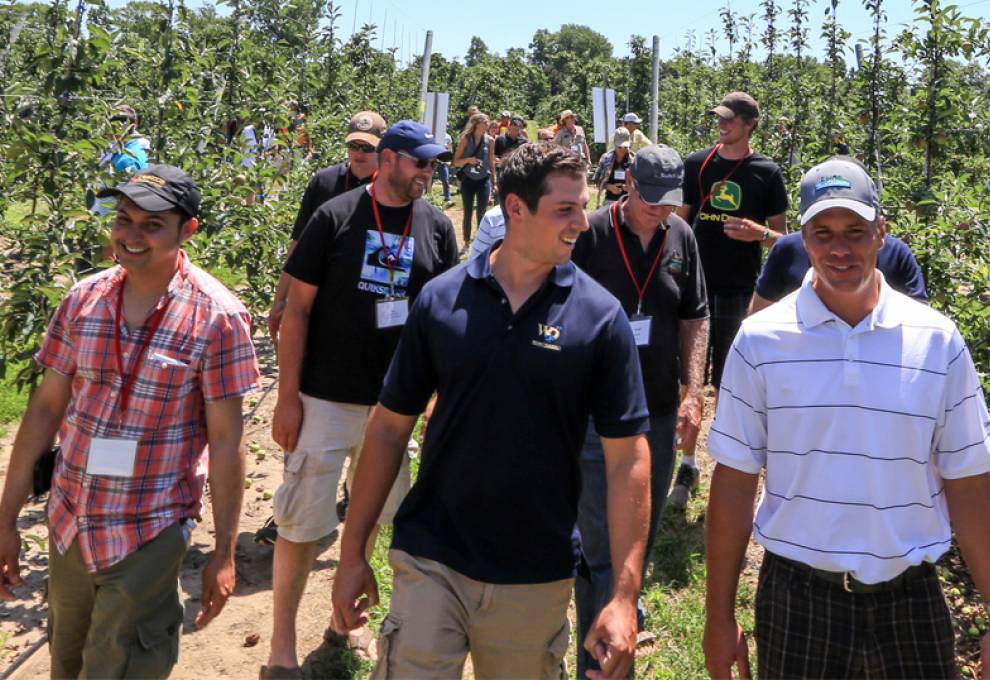
Millennials grow cooperatively to compete globally
Information is liquid. That’s how Brian Rideout describes this age of information overload, cascading from multiple sources. He’s one of about 20 young Ontario apple farmers, mostly millennials, who share experiences in a loosely structured group.
While he’s 46 and a generation X’er, he fits in easily. He didn’t grow up on a farm but he’s comfortable bridging the baby boomer farmers such as his father-in-law, Rusty Smith, Blenheim, Ontario. Rideout helps manage Manitree Fruit Farms, with 300-plus acres of apples, tender fruit and squash.
Technology exchange is crucial to competing in the global apple industry that has been revolutionized in the last decade with new varieties (Honeycrisp), high-density trellis systems (tall spindles) and more targeted crop protection products.
“Pruning is no longer about cutting off branches but about how to grow branches,” says Rideout. The philosophy has changed to thinking about where the branches will grow and how fast for the best quality. Other growers such as Gerbe Botden, Thornbury, Ontario agree that many factors are involved in precision thinning to optimize the crop load.
Botden, 24, is a second-generation grower at Botden Orchards, who remembers the first organized meeting at Ontario Apple Growers’ annual summer tour of the Georgian Bay area two years ago. Since then, the group has met two or three times a year to discuss best practices in establishing a new orchard, pruning techniques and how to access government grant programs. He’s actively engaged in 400 acres of Red Prince, Honey Crisp, Ambrosia and McIntosh varieties grown under a high-density system.
As the group moves forward in 2016, Botden is also participating in cross-border events such as the International Fruit Tree Association’s (IFTA) meetings in Grand Rapids, Michigan on February 6-12. The common thread with all of these young growers is their strong regional ties but willingness to pursue knowledge in other geographies.
Ian Parker, 25, is learning the apple industry from Charles Stevens, Wilmot Orchards, Newcastle, Ontario. “What I like about this young farmers’ group is that we’re not competing against neighbours but rather competing against the world,” says Parker. “No one wants to lose the shirt off their back. By sharing information, you have each other’s backs.”
For example, apple maggot was an aggravating pest a couple years back. The group shared information on spraying strategies as well as how to keep workers engaged while waiting for re-entry intervals to lapse.
Parker points out that Ontario has several apple-growing regions. Sharing information about thinning strategies can be very beneficial to growers in different regions. If a specific region is having unusual weather during thinning time, then it’s advantageous to share how that situation is handled.
Finetuning crop protection is a common link between all these growers. “For me, I was overwhelmed by the world of chemistry,” says Parker, “but after four years, I feel more confident about what to spray and when. I realize I’m not the only one struggling to keep up.
Brian Rideout says that smart sprayers have been found lacking in their durability and adaptability to high-density apple orchards. Tower sprayers that can deposit spray droplets more directly to 12-foot trees are now under investigation. Multiple-pass sprayers that can mow grass and spray at the same time are also of interest.
This millennial generation is very tech-savvy, taking full advantage of the Fruit Tracker program that's been developed by the Ontario apple, tender fruit and grape organizations. In addition, Rideout says every farmer has a favourite weather app. Downloaded from Apple’s Itunes, the Storm weather app uses Google Earth to zoom in on areas as precise as concession roads. It features high-definition radar, advanced storm tracking and real-time severe weather alerts. “I can tell whether a storm will hit me in 15 minutes or an hour,” says Rideout. “That allows me to pull workers out of the orchard or to pull my sprayer.”
Another app is Wind Meter by Going Apps LLC. It helps to gauge proper spraying conditions. His third favourite is an app for measuring fields which is called Measure Your Land by MYL Light. This is helpful in calculating precise spraying rates for specific blocks.
What does the older generation think of all this? Leslie Huffman, retired Ontario apple specialist, sowed the seeds for this group. “I am very pleased to see this Young Growers group moving ahead and continuing to provide links for young growers from all districts in Ontario. And I like that they perceive that rather than competing against each other, they are forming a team.”
There are some basics worth repeating, such as how to set up a tractor to avoid flat tires in the orchard. Or how to add some sugar to your spray tank so that you’re attracting beneficial insects. This is old-time lore that doesn’t always appear in 2016 scientific literature.
Ontario Apple Growers have provided administrative support to this fledgling group, sponsoring a lunch meeting, for example, at this month’s Ontario Fruit and Vegetable Convention. The association is not organizing an Ontario summer tour but rather encouraging all growers to attend IFTA’s regional study tour from Rochester to Geneva, New York from July 18-21.
Ian Parker is looking forward to a better production year in 2016. It’s now time for the group to start capturing local information in a spreadsheet that’s shareable.
“How did we manage apple maggot two years ago? How did a new miticide stand up to insect pressure last year? Our management strategies should be shared so that we’re a stronger industry,” says Parker.
Several important statistics stood out at the January 12 Ontario Apple Growers’ annual general meeting. About one-third of the province’s 16,000 apple acres has been planted in the last decade. Twenty-six per cent of the plantings are to popular, value-added varieties of Gala, Honeycrisp and Ambrosia. In the last five years, 1100 acres were planted to Gala. Another indicator of rejuvenation is a group of 20 young apple growers. As part of last summer’s Ontario Apple Growers’ summer tour to Essex County, many of them gathered to learn the latest technology at the Fruit Wagon, Harrow, Ontario.
PHOTO 1: In the front line of this group, from left to right is, Luis Ruiz, Ian Parker and Richard Feenstra. Photo by Glenn Lowson.
PHOTO 2: Two generations of apple growers from the Georgian Bay Fruit Growers compare notes at the 2015 Ontario Fruit and Vegetable Convention. Left to right: Kyle and Brad Oakley, Marius and Gerbe Botden. Both Kyle Oakley and Gerbe Botden are members of the Young Apple Growers. Photo by Denis Cahill.
No one wants to lose the shirt off their back. By sharing information, you have each other’s backs.
~ Ian Parker
Key words: Young apple growers, Ontario Apple Growers, Ian Parker, Gerbe Botden, Brian Rideout

Add new comment